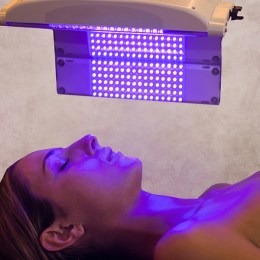The first platelet-rich fibrin treatment has landed in Australia
Platelet-Rich Fibrin (PRF) treatments are officially launching at Hair and Skin Science clinics in March 2022. The clinic will be the first In Australia to provide PRF services for hair loss and skin rejuvenation.
“We are so excited to be the first in Australia to offer PRF treatments!” says Royce Newton, the co-director of Hair and Skin Science.
With six brick-and-mortar locations across Brisbane, Melbourne and Sydney, the newest addition to the company’s treatment menu solidifies Hair and Skin Science’s status as a leading clinic in Australia.
This new treatment has gained popularity in the US and become a favourite in the aesthetics world, and has now received the TGA tick of approval. PRF is the second generation of platelet-rich plasma (PRP) treatments giving better and longer-lasting results.
PRP is a well-liked, natural treatment, and a popular less invasive alternative to dermal fillers, with superior results. Both PRF and PRP use the body’s own cells from the patient’s blood for rejuvenation, skin maintenance, and to combat and delay ageing.
“PRP can be an effective way to treat an array of skin concerns, including ageing and preventative ageing, uneven skin tone, pigmentation and acne scarring,” says Dr Cara Ting from Hair and Skin Science. PRP can also an effective treatment for hair loss, which is one of Hair and Skin Science’s most popular treatments, and PRF is expected to do just as well in the clinic.
PRF treatments can be used to:
- Improve skin tone, texture and elasticity
- Rectify UV damage
- Treat acne scarring
- Minimise the appearance of pores
- Minimise fine lines & wrinkles
- Treat pigmentation
We spoke with Dr Ting to find out more about PRF and what makes this treatment so innovative.
What are the main differences between PRF and PRP?
With traditional PRP, blood is collected and mixed with an anti-coagulant called acid citrate dextrose (ACD). The key difference with PRF is no anticoagulant is used during the spinning of the blood. The main reason PRF gets better results than PRP is that it gives clients the same benefits as PRP, but with the added benefit of releasing more growth factors so it goes on working long after the procedure is completed.
PRP stimulates the production of new collagen and elastin. The process creates a reduction in fine lines and wrinkles, helping to minimise scarring and pigmentation while improving the overall tone and texture of the skin.
What are the most common treatment areas?
- Under-eyes: to treat dark circles
- Overall face: to boost glow and smooth the complexion
- Neck: to tighten and refine the skin
- Mouth: to minimise lines
- Crepey skin: to improve tone and elasticity
- Hair loss: to stimulate hair growth
Can you walk us through the process of a PRF treatment?
PRF treatments involve injecting a small amount of one’s own blood into slowly healing soft tissue injuries to speed up the body’s own healing process. The injections are prepared by taking the patient’s blood and running it through a centrifuge to concentrate the platelets. These activated platelets are then injected directly into the injured or diseased body tissue (i.e. the treatment area). This releases growth factors that stimulate and increase the number of reparative cells the body produces.
With traditional PRP, blood is collected and mixed with an anti-coagulant called acid citrate dextrose (ACD). The key difference with PRF is that no anticoagulant is used during the spinning of the blood, this releases more growth factors so it goes on working long after the procedure is completed, giving better longer lasting results than traditional PRP.
How many PRF treatments are needed?
Generally 2–3 treatments spaced apart by 4–6 weeks for the best, long-lasting results.
Hair and Skin Science is the first in Australia to offer this revolutionary treatment. Will PRF be available at all your clinics?
Yes! PRF treatments will be available at all our clinics, including our newly opened Parramatta clinic, from March.
For more information, visit www.hairandskinscience.com.au/




